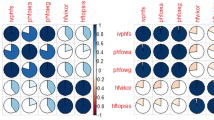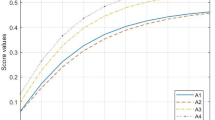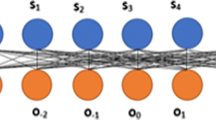Abstract
With massive growth in decision-making theory, representation of preference information plays an indispensable role. To rationally handle uncertainty, scholars presented different ideas of which hesitant fuzzy linguistic term set (HFLTS) is a good choice to represent hesitancy in decision makers’ (DMs) preferences. The challenge with HFLTS is that it cannot be used for representing complex linguistic terms. To better circumvent this challenge, double-hierarchy HFLTS (DHHFLTS) is presented. Motivated by the power of DHHFLTS in expressing complex linguistic terms by using two linguistic hierarchies, a decision framework is proposed under the DHHFLTS context. Initially, the framework presents a new aggregation operator called simple double-hierarchy frequency match aggregation operator for sensible aggregation of DMs’ preference information. Later, the mathematical programming model is extended under the DHHLTS context for rational estimation of attribute weight with partially known information. Also, the popular Vise Kriterijumska Optimizacija Kompromisno Resenje ranking method is extended under the DHHFLTS context for the selection of a suitable object from the set of objects. Finally, the proposed decision framework is validated for its practicality by demonstrating two numerical examples viz., green supplier selection problem and renewable energy source selection problem. Also, the strengths and weaknesses of the proposed framework are realized by comparison with other methods.




Similar content being viewed by others
Explore related subjects
Discover the latest articles, news and stories from top researchers in related subjects.References
Al-shami TM, El-Shafei ME (2020) Partial belong relation on soft separation axioms and decision-making problem, two birds with one stone. Soft Comput 24(7):5377–5387. https://doi.org/10.1007/s00500-019-04295-7
Atanassov KT (1986) Intuitionistic fuzzy sets. Fuzzy Sets Syst 20:87–96. https://doi.org/10.1016/S0165-0114(86)80034-3
Bai C, Zhang R, Qian L, Wu Y (2016) Comparisons of probabilistic linguistic term sets for multi-criteria decision making. Knowl-Based Syst 119:284–291. https://doi.org/10.1016/j.knosys.2016.12.020
Beg I, Rashid T (2014) TOPSIS for hesitant fuzzy linguistic term sets. Int J Intell Syst 29(2):495–524. https://doi.org/10.1002/int
Büyüközkan G, Görener A (2015) Evaluation of product development partners using an integrated AHP-VIKOR model. Kybernetes 44(2):220–237. https://doi.org/10.1108/K-01-2014-0019
Chatterjee K, Kar S (2018) A multi-criteria decision making for renewable energy selection using Z-Numbers. Technol Econ Dev Econ 24(2):739–764. https://doi.org/10.3846/20294913.2016.1261375
El-Shafei ME, Al-shami TM (2020) Applications of partial belong and total non-belong relations on soft separation axioms and decision-making problem. Comput Appl Math. https://doi.org/10.1007/s40314-020-01161-3
Fouladian M, Hendessi F, Pourmina MA (2016) Using AHP and interval VIKOR methods to gateway selection in integrated VANET and 3G heterogeneous wireless networks in sparse situations. Arab J Sci Eng 41(8):2787–2800. https://doi.org/10.1007/s13369-015-2010-5
Gou X, Liao H (2019) About the double hierarchy linguistic term set and its extensions. ICSES Trans Neural Fuzzy Comput 2(2):14–21
Gou X, Xu Z (2016) Novel basic operational laws for linguistic terms, hesitant fuzzy linguistic term sets and probabilistic linguistic term sets. Inf Sci 372:407–427. https://doi.org/10.1016/j.ins.2016.08.034
Gou X, Liao H, Xu Z, Herrera F (2017) Double hierarchy hesitant fuzzy linguistic term set and MULTIMOORA method: a case of study to evaluate the implementation status of haze controlling measures. Inf Fusion 38:22–34. https://doi.org/10.1016/j.inffus.2017.02.008
Gou X, Xu Z, Liao H, Herrera F (2018) Multiple criteria decision making based on distance and similarity measures under double hierarchy hesitant fuzzy linguistic environment. Comput Ind Eng 126(October):516–530. https://doi.org/10.1016/j.cie.2018.10.020
Hafezalkotob A, Hafezalkotob A (2016) Fuzzy entropy-weighted MULTIMOORA method for materials selection. J Intell Fuzzy Syst 31(3):1211–1226. https://doi.org/10.3233/IFS-162186
Herrera F, Herrera-Viedma E (2000) Linguistic decision analysis: steps for solving decision problems under linguistic information. Fuzzy Sets Syst 115(1):67–82. https://doi.org/10.1016/S0165-0114(99)00024-X
Herrera F, Herrera-Viedma E, Verdegay JL (1995) A sequential selection process in group decision making with a linguistic assessment approach. Inf Sci 239(1995):223–239
Herrera F, Herrera-Viedma E, Verdegay JL (1997a) A rational consensus model in group decision making using linguistic assessments. Fuzzy Sets Syst 88:31–49. https://doi.org/10.1016/S0165-0114(96)00047-4
Herrera F, Herrera-Viedma E, Verdegay JL (1997b) Linguistic measures based on fuzzy coincidence for reaching consensus in group decision making. Int J Approx Reason 16(96):309–334. https://doi.org/10.1016/S0888-613X(96)00121-1
Indragandhi V, Subramaniyaswamy V, Logesh R (2017) Resources, configurations, and soft computing techniques for power management and control of PV/wind hybrid system. Renew Sustain Energy Rev 69:129–143. https://doi.org/10.1016/j.rser.2016.11.209
Jin F, Pei L, Chen H, Zhou L (2014) Interval-valued intuitionistic fuzzy continuous weighted entropy and its application to multi-criteria fuzzy group decision making. Knowl-Based Syst 59:132–141. https://doi.org/10.1016/j.knosys.2014.01.014
Kao C (2010) Weight determination for consistently ranking alternatives in multiple criteria decision analysis. Appl Math Model 34(7):1779–1787. https://doi.org/10.1016/j.apm.2009.09.022
Krishankumar R, Ravichandran KS, Sneha S, Shyam S, Kar S, Garg H (2020) Multi-attribute group decision-making using double hierarchy hesitant fuzzy linguistic preference information. Neural Comput Appl. https://doi.org/10.1007/s00521-020-04802-0
Liao H, Xu Z, Zeng X-J (2014) Hesitant fuzzy linguistic VIKOR method and its application in qualitative multiple criteria decision making. IEEE Trans Fuzzy Syst. https://doi.org/10.1109/TFUZZ.2014.2360556
Liao H, Jiang L, Xu Z, Xu J, Herrera F (2017a) A linear programming method for multiple criteria decision making with probabilistic linguistic information. Inf Sci 416:341–355. https://doi.org/10.1016/j.ins.2017.06.035
Liao H, Xu Z, Herrera-Viedma E, Herrera F (2017b) Hesitant fuzzy linguistic term set and its application in decision making: a state-of-the-art survey. Int J Fuzzy Syst. https://doi.org/10.1007/s40815-017-0432-9
Liao H, Mi X, Xu Z (2019) A survey of decision-making methods with probabilistic linguistic information: bibliometrics, preliminaries, methodologies, applications and future directions. Fuzzy Optim Decis Mak 19:81–134
Lima Junior FR, Osiro L, Carpinetti LCR (2014) A comparison between fuzzy AHP and fuzzy TOPSIS methods to supplier selection. Appl Soft Comput J 21(August):194–209. https://doi.org/10.1016/j.asoc.2014.03.014
Lin M, Xu Z, Zhai Y, Yao Z (2017) Multi-attribute group decision-making under probabilistic uncertain linguistic environment. J Oper Res Soc. https://doi.org/10.1057/s41274-017-0182-y
Liu H-C, You J-X, You X-Y, Shan M-M (2015) A novel approach for failure mode and effects analysis using combination weighting and fuzzy VIKOR method. Appl Soft Comput J 28:579–588. https://doi.org/10.1016/j.asoc.2014.11.036
Liu Z, Zhao X, Li L, Wang X, Wang D (2019) A novel multi-attribute decision making method based on the double hierarchy hesitant fuzzy linguistic generalized power aggregation operator. Information (Switzerland). https://doi.org/10.3390/info10110339
Luthra S, Kumar S, Garg D, Haleem A (2015) Barriers to renewable/sustainable energy technologies adoption: Indian perspective. Renew Sustain Energy Rev 41:762–776. https://doi.org/10.1016/j.rser.2014.08.077
Opricovic S (2009) A compromise solution in water resource planning. Water Resour Manag 23:1549–1561
Opricovic S (2011) Fuzzy VIKOR with an application to water resources planning. Expert Syst Appl 38(10):12983–12990. https://doi.org/10.1016/j.eswa.2011.04.097
Opricovic S, Tzeng GH (2004) Compromise solution by MCDM methods: a comparative analysis of VIKOR and TOPSIS. Eur J Oper Res 156(2):445–455. https://doi.org/10.1016/S0377-2217(03)00020-1
Opricovic S, Tzeng GH (2007) Extended VIKOR method in comparison with outranking methods. Eur J Oper Res 178(2):514–529. https://doi.org/10.1016/j.ejor.2006.01.020
Pang Q, Wang H, Xu Z (2016) Probabilistic linguistic term sets in multi-attribute group decision making. Inf Sci 369:128–143. https://doi.org/10.1016/j.ins.2016.06.021
Rodriguez RM, Martinez L, Herrera F (2012) Hesitant fuzzy linguistic term sets for decision making. IEEE Trans Fuzzy Syst 20(1):109–119. https://doi.org/10.1109/TFUZZ.2011.2170076
Rodríguez RM, Labella Á, Martínez L (2016) An overview on fuzzy modelling of complex linguistic preferences in decision making. Int J Comput Intell Syst 9(April):81–94. https://doi.org/10.1080/18756891.2016.1180821
Saaty TL, Ozdemir MS (2003) Why the magic number seven plus or minus two. Math Comput Model 38(3):233–244. https://doi.org/10.1016/S0895-7177(03)90083-5
Salehi K (2016) An integrated approach of fuzzy AHP and fuzzy VIKOR for personnel selection problem. Glob J Manag Stud Res 3(3):89–95
Shemshadi A, Shirazi H, Toreihi M, Tarokh MJ (2011) A fuzzy VIKOR method for supplier selection based on entropy measure for objective weighting. Expert Syst Appl 38(10):12160–12167. https://doi.org/10.1016/j.eswa.2011.03.027
Spearman C (1904) The proof and measurement of association between two things. Am J Psychol 15(1):72–101
Tang Y, Zheng J (2006) Linguistic modelling based on semantic similarity relation among linguistic labels. Fuzzy Sets Syst 157(12):1662–1673. https://doi.org/10.1016/j.fss.2006.02.014
Torra V (2010) Hesitant fuzzy sets. Int J Intell Syst 25(2):529–539. https://doi.org/10.1002/int
Torra V, Narukawa Y (2009) On hesitant fuzzy sets and decision. IEEE Int Conf Fuzzy Syst. https://doi.org/10.1109/FUZZY.2009.5276884
Wang JH, Hao J (2006) A new version of 2-tuple fuzzy linguistic representation model for computing with words. IEEE Trans Fuzzy Syst 14(3):435–445. https://doi.org/10.1109/TFUZZ.2006.876337
Xia M, Xu Z (2012) Entropy/cross entropy-based group decision making under intuitionistic fuzzy environment. Inf Fusion 13(1):31–47. https://doi.org/10.1016/j.inffus.2010.12.001
Xu Z (2004a) A method based on linguistic aggregation operators for group decision making with linguistic preference relations. Inf Sci 166(1–4):19–30. https://doi.org/10.1016/j.ins.2003.10.006
Xu ZS (2004b) EOWA and EOWG operators for aggregating linguistics labels based on linguistic preference relations. Int J Uncertain Fuzziness Knowl Based Syst 12(06):791–810. https://doi.org/10.1142/S0218488504003211
Xu Z (2006) An approach based on the uncertain LOWG and induced uncertain LOWG operators to group decision making with uncertain multiplicative linguistic preference relations. Decis Support Syst 41(2):488–499. https://doi.org/10.1016/j.dss.2004.08.011
Xu Z (2012) Linguistic decision making: theory and methods. In: Linguistic decision making: theory and methods, vol 9783642294. https://doi.org/10.1007/978-3-642-29440-2
Yazdani M, Chatterjee P, Zavadskas EK, Hashemkhani Zolfani S (2017) Integrated QFD-MCDM framework for green supplier selection. J Clean Prod 142(October):3728–3740. https://doi.org/10.1016/j.jclepro.2016.10.095
Zhai Y, Xu Z, Liao H (2016) Probabilistic linguistic vector-term set and its application in group decision making with multi-granular linguistic information. Appl Soft Comput J 49:801–816. https://doi.org/10.1016/j.asoc.2016.08.044
Zhang X, Xing X (2017) Probabilistic linguistic VIKOR method to evaluate green supply chain initiatives. Sustainability 9(7):1231. https://doi.org/10.3390/su9071231
Zhang Y, Li P, Wang Y, Ma P, Su X (2013) Multiattribute decision making based on entropy under interval-valued intuitionistic fuzzy environment. Math Probl Eng 2013:1–8. https://doi.org/10.1016/j.eswa.2012.01.027
Zhang G, Dong Y, Xu Y (2014) Consistency and consensus measures for linguistic preference relations based on distribution assessments. Inf Fusion 17(1):46–55. https://doi.org/10.1016/j.inffus.2012.01.006
Zhao X, Zou T, Yang S, Yang M, Problem A (2012) Extended VIKOR method with fuzzy cross-entropy of interval-valued intuitionistic fuzzy sets. In: Proceedings of the 2012 2nd international conference on computer and information application (ICCIA 2012), (Iccia), pp 1093–1096
Zhao H, You JX, Liu HC (2016) Failure mode and effect analysis using MULTIMOORA method with continuous weighted entropy under interval-valued intuitionistic fuzzy environment. Soft Comput. https://doi.org/10.1007/s00500-016-2118-x
Zhu B, Xu Z (2014) Consistency measures for hesitant fuzzy linguistic preference relations. IEEE Trans Fuzzy Syst 22(1):35–45. https://doi.org/10.1109/TFUZZ.2013.2245136
Zhu B, Xu Z, Xia M (2012) Dual hesitant fuzzy sets. J Appl Math. https://doi.org/10.1155/2012/879629
Funding
This study was funded by University Grants Commission (UGC), India (Grant No: F./2015-17/RGNF-2015-17-TAM-83) and Department of Science and Technology (DST), India (Grant No: SR/FST/ETI-349/2013).
Author information
Authors and Affiliations
Corresponding author
Ethics declarations
Conflict of interest
All authors of this research paper declare that, there is no conflict of interest.
Ethical approval
This article does not contain any studies with human participants or animals performed by any of the authors.
Additional information
Communicated by V. Loia.
Publisher's Note
Springer Nature remains neutral with regard to jurisdictional claims in published maps and institutional affiliations.
Rights and permissions
About this article
Cite this article
Krishankumar, R., Ravichandran, K.S., Kar, S. et al. Double-hierarchy hesitant fuzzy linguistic term set-based decision framework for multi-attribute group decision-making. Soft Comput 25, 2665–2685 (2021). https://doi.org/10.1007/s00500-020-05328-2
Published:
Issue Date:
DOI: https://doi.org/10.1007/s00500-020-05328-2




